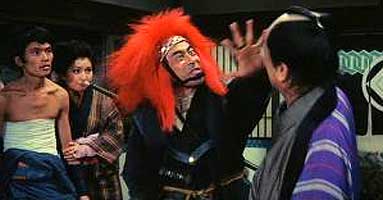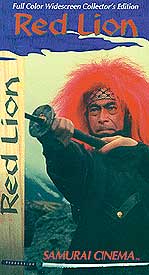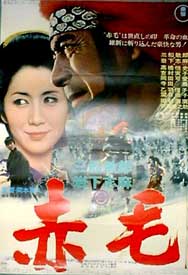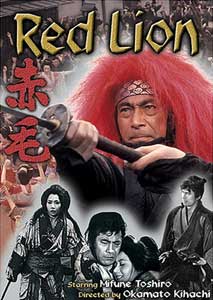The samurai films produced by Toshiro Mifune's own production company tended to be somewhat conservative "products" rather than films that strove to be adult art, because he worried about finances & felt the burden of responsibility to everyone who worked for him. But with Red Lion (Akage, 1969) his company hit upon the perfect blend of action-packed brightly-colored commerse, & tale with depth, performed with depth.
 Director Kihachi Okamoto was able to inspire one of Mifune's finer comic performances. Okamoto had previously made one of the greatest of all samurai films, Sword of Doom (1966), & got a something so scary & great out of Tatsuya Nakadai that he rose above his usual high standard of acting, & the film had a smaller dour role for Mifune as well. He also got out of Mifune one of his better non-comedic performances in Samurai Assassin (1965), perhaps the only film from Mifune Productions that made the attempt to be high art (imitating in particular Masaki Kobayashi), but got weighted down as a veritable lecture on history & politics at the end of the Tokugawa era. Director Kihachi Okamoto was able to inspire one of Mifune's finer comic performances. Okamoto had previously made one of the greatest of all samurai films, Sword of Doom (1966), & got a something so scary & great out of Tatsuya Nakadai that he rose above his usual high standard of acting, & the film had a smaller dour role for Mifune as well. He also got out of Mifune one of his better non-comedic performances in Samurai Assassin (1965), perhaps the only film from Mifune Productions that made the attempt to be high art (imitating in particular Masaki Kobayashi), but got weighted down as a veritable lecture on history & politics at the end of the Tokugawa era.
Okamoto had been something of an "anti samurai" samurai filmmaker, who didn't make the usual heroic assumptions about the samurai class, rarely treating their predilection for slaughter as a heroic thing, unlike Hiroshi Inagaki & even Akira Kurosawa who generally presume various degrees of greatness in samurai & won't question that stance.
With Red Lion, Okamoto selects a peasant-warrior as heroic protagonist, & Mifune plays him with enormous humor & quite loudly, yet with surprising depth. The script was by Kaneto Shindo who whether as screenwriter or director was himself a left-leaning peasant advocate with criticisms of the buke or warrior class, as in his own masterpiece Onibaba (1964).
During the pre-credits sequence we are given an introductory image of peasants dancing to the chant of "Eijanaika! Eijanaika!" which means "So what? Who cares!" Hstorically there was a Eijanaika movement in which peasants began to celebrate life even though there was no reason to do so.
That happy party lasted about one year, in 1867, in many parts of Japan. Taxes ridiculously high? Eijanaika! Oppression & injustice? Eijanaika! The whole family is starving to death? Eijanaika!
Instead of rioting or arming themselves, across Japan peasants danced & sang, a precursor to Gandhi's teachings of peaceful protest. The government reacted as most governments do to non-violent action, they sent riot squads to kill people. A perfect image to start off a left-leaning Kaneto Shindo script!
Thus, even though in general appearance this is another flashy epic more like Inagaki films than Okamoto, it had a more thoughtful author & a director with more strongly artistic inclinations & a capacity to get good work out of actors. The result is that Red Lion has greater emotional authenticity & showcases Mifune at his best.
 Mifune's character Gonzo is naive, sweet, unbathed, physically mighty, a stutterer, & nearly always happy. As a youth he had fallen out of a persimmon tree & landed on his head, which accounted for his slowness of wit, but the important aspect of that tumble was that he never did let go of that persimmon. Mifune's character Gonzo is naive, sweet, unbathed, physically mighty, a stutterer, & nearly always happy. As a youth he had fallen out of a persimmon tree & landed on his head, which accounted for his slowness of wit, but the important aspect of that tumble was that he never did let go of that persimmon.
Under any other director I'm sure this broad performane would seem merely over-acted, but the innocence of the character somehow centers the performance resulting in something that is at the high end of great. For this performance, Mifune received the Best Actor in the Venice Film Festival, but for many years afterward the film seems to have been dismissed as "mere" adventure & only with the dvd revolution has Red Lion become well known in the west.
Gonzo left his home village a nobody & returned ten years later as a representative of a royalist army spreading the news that taxes would be cut in half & all classes would be treated as equals once the Tokugawa regime was defeated. Japan was on the cusp of opening its ports to the west, with upheavels prelude to the Meiji Restoration.
 When Gonzoburo was sent in advance to win over his own village, he wanted more than the cheap armband as proof that he's a royalist captain. He wanted to borrow 5h3 huge red wig of his commander (Takahiro Tamura) so that he could ride into his village with a hero's glamorousness. His commander said it is never done, only the royalist leaders wore those wigs. But as happy Gonzo pets his commander's head & dotes on the wig, the man is infected with Gonzo's inherent goodwill, & relents. Gonzo, feeling like a bigwig so to speak, rides off whooping & shouting for joy, the red Noh Drama wig (or Kogen comedy!) blowing like a roan stallion's mane in the wind. When Gonzoburo was sent in advance to win over his own village, he wanted more than the cheap armband as proof that he's a royalist captain. He wanted to borrow 5h3 huge red wig of his commander (Takahiro Tamura) so that he could ride into his village with a hero's glamorousness. His commander said it is never done, only the royalist leaders wore those wigs. But as happy Gonzo pets his commander's head & dotes on the wig, the man is infected with Gonzo's inherent goodwill, & relents. Gonzo, feeling like a bigwig so to speak, rides off whooping & shouting for joy, the red Noh Drama wig (or Kogen comedy!) blowing like a roan stallion's mane in the wind.
The prodigal son deeply believes in the royalist cause & begins spreading the news that the Tokugawa government is about to collapse, the Emperor will soon be reinstated as sole sovereign, & a new age will arise in which peasants are no longer overtaxed & oppressed. An age of equality is about to begin! All of this impresses his old friends.
His boasts & promises are to be tested at once, for he has arrived on the very day the Tokugawa regime is collecting further taxes to support their battles against the imperialists. Having already been taxed into extreme poverty & indebted to a local moneylender, for many there is simply nothing more to be squeezed out of them. Yet hostages are being held & if the levy is unpaid by dawn, the male hostages will be killed & the wives or daughters put in a bordello.
Right off the bat he has to stop old Gohei (Bokuzen Hidari, the tragic-faced geezer who got strung up in Yojimbo) from committing suicide by hanging himself from a tree in the town center. His granddaughter Osode was taken in lieu of unpaid taxes, to be indentured in the bordello run by the combination gangster/magistrate Komatara (Tokue Hanazawa), the same bordello where Gonzo's old girlfriend Tomi (Shima Iwashita) has been forced to work.
Gonzo has also learned that his father died & the family farm lost to previous over-taxation, & his mother lives hand to mouth with Tomi's assistance. Gonzo's sister had been raped by Komatora which together with the extreme hardship had driven her insane, so that she dwells like a ghost in the family's ruined farmhouse.
Assisted by a self-appointed lieutenant, Sanji the pickpocket from Edo (Minori Terada), Gonza sets out to right whatever wrongs are repairable, destroying the indenture contracts for the women forced into prostitution, breaking into the rice stores to feed the starving people, & inspiring hope among the hopeless. Shogunate loyalists conspire against Gonzo, but he is insurmountable. His hometown folks begin to regard him as the liberating "god of peasants."
Amidst this absolutely wonderful human comedy is true peasant heroism against all forces of ill will. Gonzo is so completely endearing & Mifune's physical acting so credible that he has only occasionally been this real. He plays heroism close to the edge of bafoonery, but it is Gonzo's joyful heroism that predominates & the script as well as the performance sustains his dignity even if he does fall off his horse crying, "ouch ouch ouch ouch" or runs from room to room in the bordello calling out joyfully for his beloved "Tomi tomi tomi tomi."
The corrupt official/yakuza pimp Komotora tries to hire a ronin named Hanzo (Etsushi Takahashi) as his yojimbo, paying him to get rid of "that Red Lion guy." Hanzo admires Gonzo but is a cynically pragmatic man, & well knows that big promises are easy to make, but that a change of leaders is not seriously apt to result in tax relief, debt forgiveness, & equality for all. Hanzo doesn't really want to kill Gonzo, but if paid enough, he'll do almost anything, if not too busy drinking to get round to it.
A simple story but rich in incident: the fate of Gonzo's sister & her former betrothed; the two little speeches by Gonzo's mother (one that sends him in a depression, another that restores his innocence & might); the death of a young town hero; Tomi's misguided betrayal followed by her loving sacrifice; the disillusion & final stand of Gonzo...every twist & event in the story absolutely works. There's not one sour note in this elegy to peasant hope & heroism.
Gonzo's commander probably also believed in the royalist promises & led his peasant army in all sincerity. But history's Sagara Sozo was himself trapped in a larger scheme that was to be his undoing. Idle promises were made to peasants to keep them from assisting the shogunate, then Sagara Sozo's little force was declared to be "imposter imperialists." Gonzo's commander is beheaded right in his camp, & the Imperial army that rides into the village is not the one that promised tax relief & equality. They are cruel & intent on suppressing protest & collecting taxes. Hanzo's cynicism was after all only reality.
After many events & sorrowful deaths, Gonzo the Red Lion faces the treacherous imperialists one against all, to very tragic effect, while the villagers begin filling the streets like a tsunami, their arms above their heads as they dance & sing, "Eijanaika! Eijanaika!"
The first time I saw this film, oh, three decades ago, I was not satisfied by the lack of an effective one-against-all duel with the hero the last man standing. I liked Gonzo too much & felt that his horrific demise did not fit the comic mood of the film. On repeat viewings, however, the subtle degree of depth to the script & of Mifune's wild & sympathetic performance impresses me more & more. Plus I have in the meantime gained a fuller understanding of the peacefully undertaken Eijanaika protests, a mightily heroic event of history worthy of the memorialization embodied by Red Lion & which movement is the wholehearted focus of Shohei Imamura's Eijanaika (1981).
I now believe Red Lion to be one of the finest films ever to blend the deep seriousness of black & white "cruel jidaigeki" films like Masaki Kobayashi's Samurai Rebellion (1967) with the full color nonstop-action heroics of a more lowbrow chambara. Red Lion manages to have it both ways: the widescreen color surface-glitz & action-packed simplicity of later Mifune Production films (such as Ambush: Incident at Blood Pass, 1970), but with so much more, because the scriptwriter & the director intended more & achieved it.
copyright © by Paghat the Ratgirl
|

 Director Kihachi Okamoto was able to inspire one of Mifune's finer comic performances. Okamoto had previously made one of the greatest of all samurai films, Sword of Doom (1966), & got a something so scary & great out of Tatsuya Nakadai that he rose above his usual high standard of acting, & the film had a smaller dour role for Mifune as well. He also got out of Mifune one of his better non-comedic performances in Samurai Assassin (1965), perhaps the only film from Mifune Productions that made the attempt to be high art (imitating in particular Masaki Kobayashi), but got weighted down as a veritable lecture on history & politics at the end of the Tokugawa era.
Director Kihachi Okamoto was able to inspire one of Mifune's finer comic performances. Okamoto had previously made one of the greatest of all samurai films, Sword of Doom (1966), & got a something so scary & great out of Tatsuya Nakadai that he rose above his usual high standard of acting, & the film had a smaller dour role for Mifune as well. He also got out of Mifune one of his better non-comedic performances in Samurai Assassin (1965), perhaps the only film from Mifune Productions that made the attempt to be high art (imitating in particular Masaki Kobayashi), but got weighted down as a veritable lecture on history & politics at the end of the Tokugawa era.
 When Gonzoburo was sent in advance to win over his own village, he wanted more than the cheap armband as proof that he's a royalist captain. He wanted to borrow 5h3 huge red wig of his commander (Takahiro Tamura) so that he could ride into his village with a hero's glamorousness. His commander said it is never done, only the royalist leaders wore those wigs. But as happy Gonzo pets his commander's head & dotes on the wig, the man is infected with Gonzo's inherent goodwill, & relents. Gonzo, feeling like a bigwig so to speak, rides off whooping & shouting for joy, the red Noh Drama wig (or Kogen comedy!) blowing like a roan stallion's mane in the wind.
When Gonzoburo was sent in advance to win over his own village, he wanted more than the cheap armband as proof that he's a royalist captain. He wanted to borrow 5h3 huge red wig of his commander (Takahiro Tamura) so that he could ride into his village with a hero's glamorousness. His commander said it is never done, only the royalist leaders wore those wigs. But as happy Gonzo pets his commander's head & dotes on the wig, the man is infected with Gonzo's inherent goodwill, & relents. Gonzo, feeling like a bigwig so to speak, rides off whooping & shouting for joy, the red Noh Drama wig (or Kogen comedy!) blowing like a roan stallion's mane in the wind.